Africa Twin Evolved
Story by Jon Beck
DBT upcoming test: Honda Africa Twin from Jon Beck on Vimeo.
DBT: Honda Africa Twin – Initial Impression from Jon Beck on Vimeo.
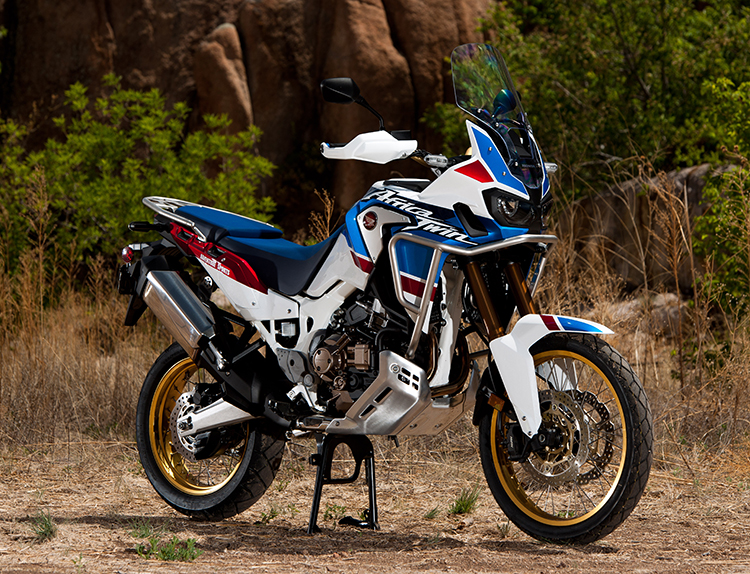
In the CRF1000L2 Africa Twin Adventure Sports, Honda has taken a classic platform and reinvented it. With its noticeably offroad-friendly chassis, and surprisingly capable stock suspension, the 2018 Africa Twin feels raw and rowdy for a big-twin dual sport. Mix these very familiar elements with the extremely unfamiliar ability to have the bike take over shifting duties in a variety of ways, and you’re in for a unique riding experience.
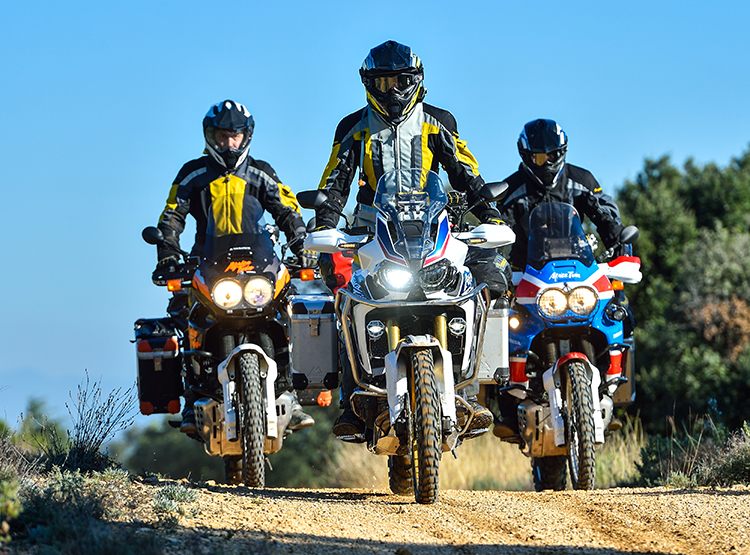
The Africa Twin’s roots go back to the legendary NXR750, which in the late 1980s rolled through the Paris-Dakar finish line in first place four times. Then in 1989 Honda released the XRV750, which borrowed from this storied and capable platform. Various iterations of this motorcycle were produced until the model line ceased in 2003. Maintaining a rabid following in the European used market, the announcement of a new Africa Twin model in 2016 was arguably one of the most anticipated model releases for the dual sport market segment, especially in North America.
DCT: The Future?
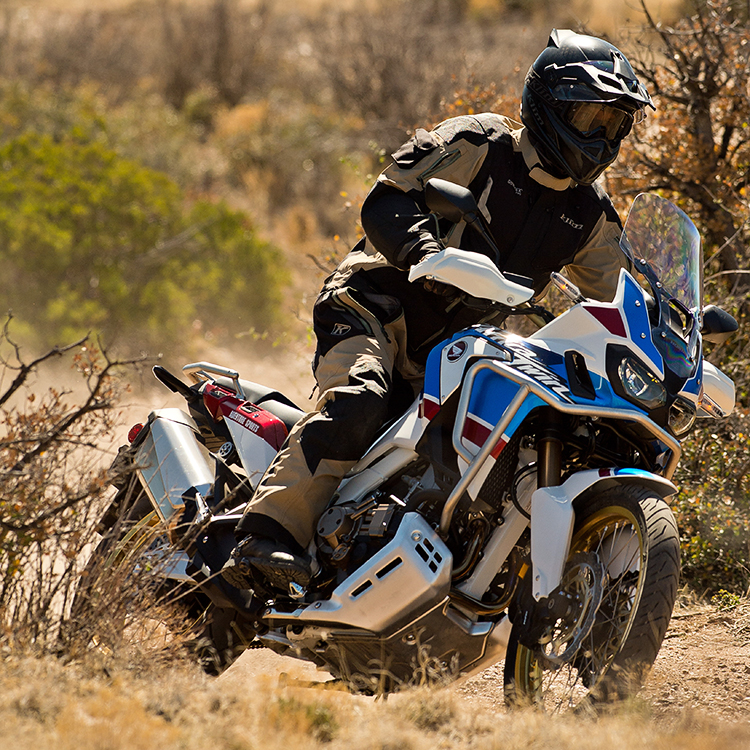
An optional and standout feature of Honda’s Africa Twin is its automatic transmission, or “Dual Clutch Transmission” (DCT). No other motorcycle in the dual sport category currently has this technology. Rolling away from the Hotel Saint Michael in Prescott, Arizona, I’ll admit reaching for a clutch lever that wasn’t there, and stomping at nothing from time to time with my left foot during the ride. Testing the many combinations of potential ride modes throughout the day was a bit like hanging out with James McAvoy’s character in M. Night Shyamalan’s movie Split. The bike has multiple personalities, except you can get along with all of them in the right context. “Tour” mode’s economical temperament can bang through multiple gears in the space of a single intersection. Adjust the power setting (“P”) and you can affect how long the bike will hold a gear. Reach down and click a paddle shifter, and you can override and have whatever gear you want at that moment, and then let the bike take over when the DCT system feels it’s done with the gear you selected. Click the bike into manual mode and you can shift as you see fit, just using paddles, not a shift lever.
Some “un-learning” of everything you’ve known about motorcycling is necessary to fully dive into the Africa Twin DCT experience. Where the clutch has always been a means of control, that is now given over to the machine. Cycling through the various modes, you’re experiencing the multiple personalities of the algorithm that’s along for the ride with you. While you can override your electronic co-pilot’s shifting decisions, it quickly becomes addicting under basic touring conditions to let the bike handle the transmission so you can appreciate the scenery. Manual mode becomes even more addicting however, as you maintain a familiar level of control, without any footwork involved.
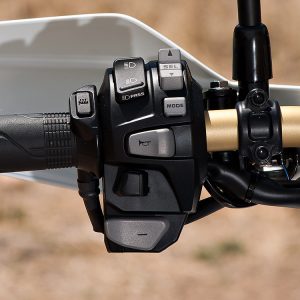 |
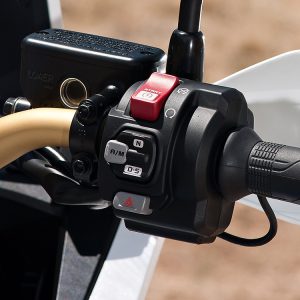 |
| Thumb war: The left bar contains a switch cluster including the familiar elements of horn, turn signal, and high beam. The high beam flasher has been moved from its traditional place on the front of the cluster, as this is now reserved for the “upshift” button, with “downshift” on the back of the switch. “MODE” and “SEL” allow the rider to scroll through the various power delivery choices. Photos: Steve Cox | |
Some practice is required to throughly ingrain the switch pattern in your mind. While the control layout is very intuitive, there are a lot of buttons on this bike which simply don’t exist on others. Relying on muscle memory can lead to pushing the wrong one. As it turns out, no matter how many times you hit the turn signal cancellation button, the bike will not downshift!?! Some of the features can be adjusted while rolling (drive mode, torque control setting, etc..), while others require rolling to a stop first (ABS on/off, gravel mode). Fortunately, a convenient rule of thumb (no pun intended) applies to knowing which is which: if the switches are on the handlebars, those features are intended to be adjustable while rolling, if the switches are on the dash, requiring your hands to leave the bars, they require rolling to a stop first.
In the space normally occupied by a clutch, a parking brake lever is positioned far enough out so as to not be accidentally yanked while riding. It took some getting used to having this feature, but I soon found it convenient having the ability to hold the bike on a hill, engine running, and right foot free to be on the ground instead of the rear brake if need be. The DCT option adds roughly $1600 to the $14,999 MSRP.
Be Aggressive
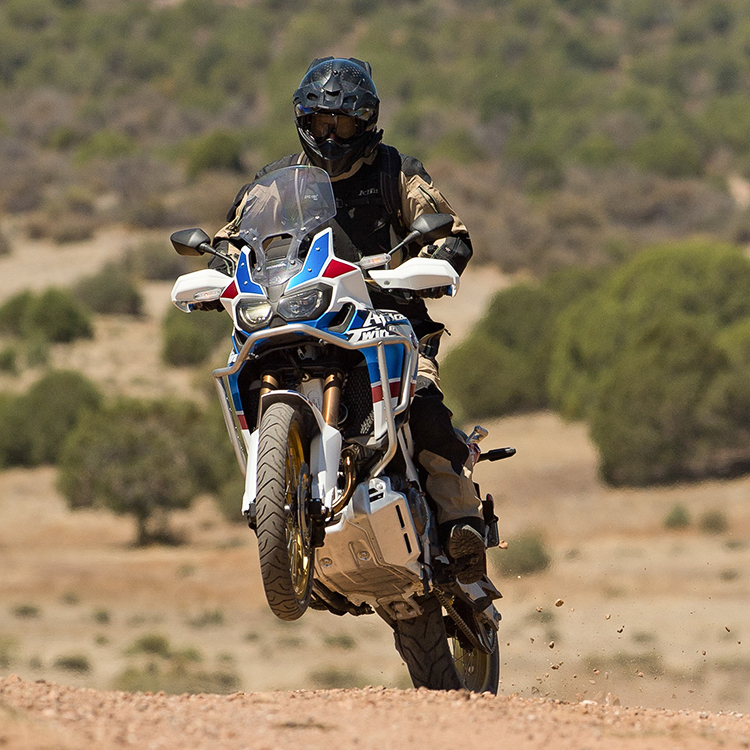
Lacking a manual clutch as a way to control power means that duty is now exclusively the throttle’s domain. Once the tires leave the pavement, shyness has no place with the Africa Twin. Aggressive use of the throttle will help coax the bike into picking more appropriate gears to get it where you need it to be. Eventually a level of familiarity sets in, and you become accustomed to when and where the power will hit. It is quite literally becoming used to the feeling of riding while someone else controls the clutch.
ABS–Anti-Lock Braking
Aggressive riding of the Africa Twin is tempered to a degree by the always-on ABS system up front. Surprisingly, I did not notice the system working throughout the vast majority of this intro ride. With the push of a button, the rear ABS can be completely turned off while the bike is at a stop. Now free to drag the rear wheel, rarely would I notice the front wheel discussing its next move with the ABS computer as we drifted through the gravel corners of this press ride. Only in the more extreme situations did the technology remind me I was not riding a dirt bike. Loft the front wheel and the computer looses its way upon landing. 1-Mississippi, 2-Mississippi, 3-Mississippi, and… ok, we now have front brakes again. If you plan on spending any time in the air on the Africa Twin, be sure you have an appropriate landing strip in front of you.
A Familiar Frame
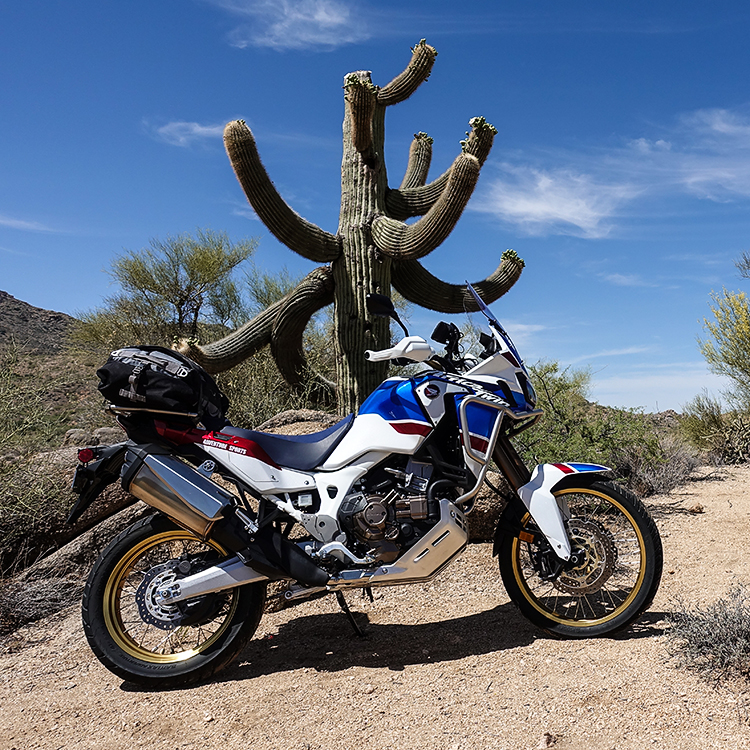
While the technology packed into the DCT version of the Africa Twin steals the show, the basic elements were no less impressive. Under the exceedingly cool throwback paint job is a narrow steel frame that feels more like a dirt bike than perhaps any other motorcycle in this class. The L2 has a more open rider triangle with bar risers and a taller seat to go along with the extended suspension travel. Bodywork, faring, dash, and a 6.4 gallon fuel tank are all attached to that frame to make one of the cleanest looking bikes around. Very little in the way of superfluous decorative bits bolted to it harkens back to the styling of the earlier Africa Twin models. The non-adjustable windscreen provides plenty of protection to duck behind when necessary. Following the press launch, I spent nearly 100 miles riding through a wind storm with gusts reaching 75 mph. In a maelstrom like that, buffeting isn’t so much of a concern as simply staying on the bike.
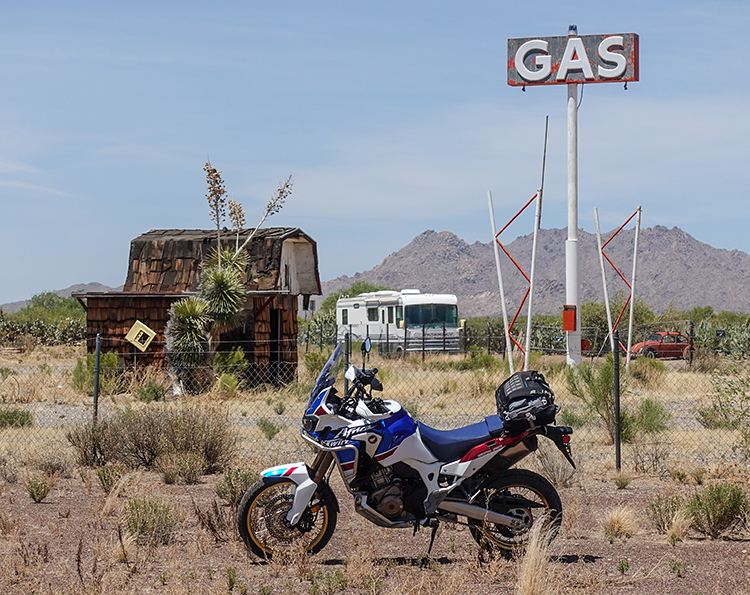
The 998cc parallel twin engine is perhaps as unique as the rest of the motorcycle. Where most of the industry continues trending towards more displacement and more power, the Africa Twin distinctly went the other direction. Opting to focus on engine feel rather than raw power output, the Africa Twin’s peak horsepower of 94 is delivered with a thumper-like pulse. A 270-degree crankshaft, uneven firing interval, and balancer shaft which shed 10.6 oz all contribute to the engine’s agreeable character. Twisting the throttle to the stop is a unique experience for a bike in this class, and the Africa Twin lets you experience the full range of its power plant. Being able to grab a gear with your left thumb is a welcome feature once you’ve reached the power ceiling.
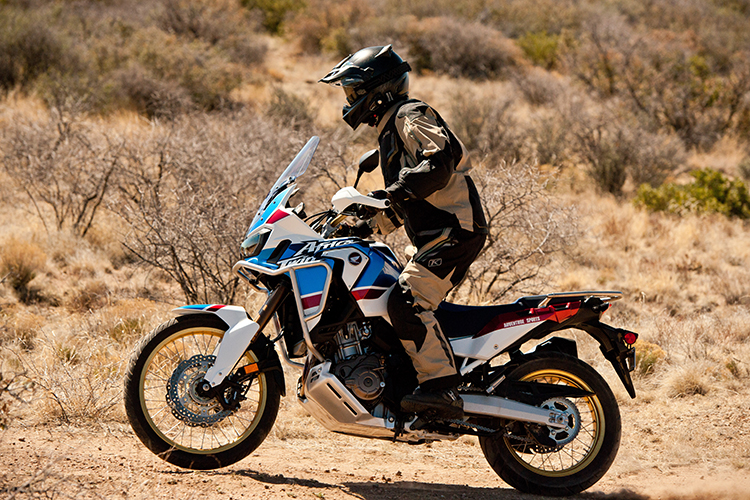
With nearly an inch more ground clearance over the standard Africa Twin, the Adventure Sports version’s manually-adjusted Showa suspension maintains the out-of-the box performance engineered into the original, with more travel. We are looking into exactly how they arrived at longer travel, but our impression is that stiffer springs and increased compression dampening are part of the setup. In this case, more is definitely better. Given my 5’11” frame, the bar risers place the grips in an ideal position for riding either seated or standing. Ironically, in spite of the extreme amount of technology woven into this machine, the cockpit of the Africa Twin Adventure Sports is perhaps the most “raw” or familiar of any bike in this class. The desert whizzes by like you’d expect it to while riding a giant XR400, until the software starts doing things with the wheels, and reminds you it’s 2018.
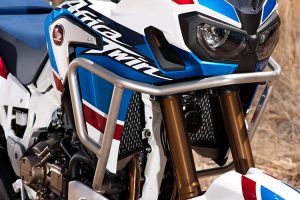 |
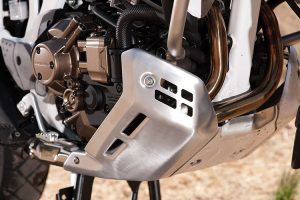 |
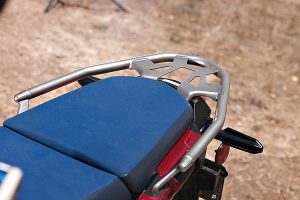 |
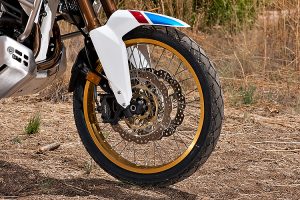 |
| Skidplate, metal rear rack, light bars, heated grips, 12V power socket and added bling of gold rims are all welcome standard features. Photo: Steve Cox | |
A Changing Industry
Where is that tipping point where technology becomes too much? Saw iPhone introducing “Bedtime” and thought occurred “they’re trying to control how I sleep now!?!” Referring to technology as good or bad is perhaps the wrong argument. At what point does one not want a loom to help weave fabric for clothes, an x-ray machine to figure out why your arm is at that funny angle, or an auto-focus camera to help make sure a photo is sharp? Where is the tipping point when mechanical assistance becomes unwanted control? More and more, we’re forced to ask these questions. Motor vehicles are a glaring example.
At first, the DCT system is perhaps awkward to the traditional dual sport rider. Becoming accustomed to this system can be compared to Apple introducing a touch screen on the first iPhone. The initial growing pains were soon forgotten, and the technology has now become the standard for smartphones and beyond. People in the 1940s must have been trying to kick holes in the floorboards of their cars, searching for clutch pedals which had vanished as automatic transmissions first made their way into production lines. Technologies like these became universal standards in short order, and Honda’s daring inclusion of an automatic transmission in an adventure motorcycle is perhaps a harbinger of things to come.
Conclusion
Due to the street bias of the tires, DBT did not feel the need or the ability to give the bike a fair evaluation off-road at this introduction. Hence the lack of findings on the chassis and suspension performance, let alone the power off-road. As soon as we get a set of proper adventure tires on the bike we’ll get a full test up and let you know if we like it as much as the earlier version.
PROS:
- Most rider settings are stored automatically without requiring additional dongle accessory
- Good factory suspension
- Geometry of peg/seat/bar triangle
- Easy ABS on/off switch
- Heated grips / 12V power port standard
- Aesthetics
CONS:
- Soft seat
- Front ABS can’t be turned off
- Centerstand would be a nice addition.

